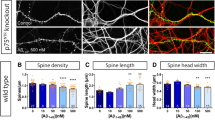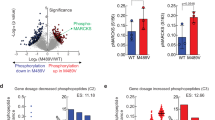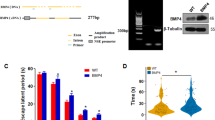Abstract
Defects in dendritic spines are common to several forms of cognitive deficits, including mental retardation and Alzheimer disease. Because mutation of p21-activated kinase (PAK) can lead to mental retardation and because PAK-cofilin signaling is critical in dendritic spine morphogenesis and actin dynamics, we hypothesized that the PAK pathway is involved in synaptic and cognitive deficits in Alzheimer disease. Here, we show that PAK and its activity are markedly reduced in Alzheimer disease and that this is accompanied by reduced and redistributed phosphoPAK, prominent cofilin pathology and downstream loss of the spine actin-regulatory protein drebrin, which cofilin removes from actin. We found that β-amyloid (Aβ) was directly involved in PAK signaling deficits and drebrin loss in Aβ oligomer–treated hippocampal neurons and in the Appswe transgenic mouse model bearing a double mutation leading to higher Aβ production. In addition, pharmacological PAK inhibition in adult mice was sufficient to cause similar cofilin pathology, drebrin loss and memory impairment, consistent with a potential causal role of PAK defects in cognitive deficits in Alzheimer disease.
This is a preview of subscription content, access via your institution
Access options
Subscribe to this journal
Receive 12 print issues and online access
$209.00 per year
only $17.42 per issue
Buy this article
- Purchase on SpringerLink
- Instant access to full article PDF
Prices may be subject to local taxes which are calculated during checkout






Similar content being viewed by others
References
Purpura, D.P. Dendritic spine “dysgenesis” and mental retardation. Science 186, 1126–1128 (1974).
Ferrer, I. & Gullotta, F. Down's syndrome and Alzheimer's disease: dendritic spine counts in the hippocampus. Acta Neuropathol. (Berl.) 79, 680–685 (1990).
Blanpied, T.A. & Ehlers, M.D. Microanatomy of dendritic spines: emerging principles of synaptic pathology in psychiatric and neurological disease. Biol. Psychiatry 55, 1121–1127 (2004).
Selkoe, D.J. Alzheimer's disease is a synaptic failure. Science 298, 789–791 (2002).
Moolman, D.L., Vitolo, O.V., Vonsattel, J.P. & Shelanski, M.L. Dendrite and dendritic spine alterations in Alzheimer models. J. Neurocytol. 33, 377–387 (2004).
Coleman, P., Federoff, H. & Kurlan, R. A focus on the synapse for neuroprotection in Alzheimer disease and other dementias. Neurology 63, 1155–1162 (2004).
Wisniewski, K.E., Wisniewski, H.M. & Wen, G.Y. Occurrence of neuropathological changes and dementia of Alzheimer's disease in Down's syndrome. Ann. Neurol. 17, 278–282 (1985).
Fiala, J.C., Spacek, J. & Harris, K.M. Dendritic spine pathology: cause or consequence of neurological disorders? Brain Res. Brain Res. Rev. 39, 29–54 (2002).
Ramakers, G.J. Rho proteins, mental retardation and the cellular basis of cognition. Trends Neurosci. 25, 191–199 (2002).
Bienvenu, T. et al. Missense mutation in PAK3, R67C, causes X-linked nonspecific mental retardation. Am. J. Med. Genet. 93, 294–298 (2000).
Allen, K.M. et al. PAK3 mutation in nonsyndromic X-linked mental retardation. Nat. Genet. 20, 25–30 (1998).
Hayashi, M.L. et al. Altered cortical synaptic morphology and impaired memory consolidation in forebrain- specific dominant-negative PAK transgenic mice. Neuron 42, 773–787 (2004).
Meng, Y. et al. Abnormal spine morphology and enhanced LTP in LIMK-1 knockout mice. Neuron 35, 121–133 (2002).
Ong, W.Y., Wang, X.S. & Manser, E. Differential distribution of alpha and beta isoforms of p21-activated kinase in the monkey cerebral neocortex and hippocampus. Exp. Brain Res. 144, 189–199 (2002).
Simic, G., Kostovic, I., Winblad, B. & Bogdanovic, N. Volume and number of neurons of the human hippocampal formation in normal aging and Alzheimer's disease. J. Comp. Neurol. 379, 482–494 (1997).
Harigaya, Y., Shoji, M., Shirao, T. & Hirai, S. Disappearance of actin-binding protein, drebrin, from hippocampal synapses in Alzheimer's disease. J. Neurosci. Res. 43, 87–92 (1996).
Calon, F. et al. Docosahexaenoic acid protects from dendritic pathology in an Alzheimer's disease mouse model. Neuron 43, 633–645 (2004).
Shim, K.S. & Lubec, G. Drebrin, a dendritic spine protein, is manifold decreased in brains of patients with Alzheimer's disease and Down syndrome. Neurosci. Lett. 324, 209–212 (2002).
Hatanpaa, K., Isaacs, K.R., Shirao, T., Brady, D.R. & Rapoport, S.I. Loss of proteins regulating synaptic plasticity in normal aging of the human brain and in Alzheimer disease. J. Neuropathol. Exp. Neurol. 58, 637–643 (1999).
Hayashi, K. et al. Modulatory role of drebrin on the cytoskeleton within dendritic spines in the rat cerebral cortex. J. Neurosci. 16, 7161–7170 (1996).
Takahashi, H. et al. Drebrin-dependent actin clustering in dendritic filopodia governs synaptic targeting of postsynaptic density-95 and dendritic spine morphogenesis. J. Neurosci. 23, 6586–6595 (2003).
Aoki, C. et al. Drebrin A is a postsynaptic protein that localizes in vivo to the submembranous surface of dendritic sites forming excitatory synapses. J. Comp. Neurol. 483, 383–402 (2005).
Lacor, P.N. et al. Synaptic targeting by Alzheimer's-related amyloid beta oligomers. J. Neurosci. 24, 10191–10200 (2004).
Janz, R. et al. Essential roles in synaptic plasticity for synaptogyrin I and synaptophysin I. Neuron 24, 687–700 (1999).
Chelly, J. & Mandel, J.L. Monogenic causes of X-linked mental retardation. Nat. Rev. Genet. 2, 669–680 (2001).
Gedeon, A.K., Nelson, J., Gecz, J. & Mulley, J.C. X-linked mild non-syndromic mental retardation with neuropsychiatric problems and the missense mutation A365E in PAK3. Am. J. Med. Genet. A 120, 509–517 (2003).
Chong, C., Tan, L., Lim, L. & Manser, E. The mechanism of PAK activation. Autophosphorylation events in both regulatory and kinase domains control activity. J. Biol. Chem. 276, 17347–17353 (2001).
Singh, R.R., Song, C., Yang, Z. & Kumar, R. Nuclear localization and chromatin targets of p21-activated kinase 1. J. Biol. Chem. 280, 18130–18137 (2005).
Yang, A.J., Knauer, M., Burdick, D.A. & Glabe, C. Intracellular Aβ1–42 aggregates stimulate the accumulation of stable, insoluble amyloidogenic fragments of the amyloid precursor protein in transfected cells. J. Biol. Chem. 270, 14786–14792 (1995).
Cataldo, A.M. et al. Abeta localization in abnormal endosomes: association with earliest Abeta elevations in AD and Down syndrome. Neurobiol. Aging 25, 1263–1272 (2004).
McPhie, D.L. et al. DNA synthesis and neuronal apoptosis caused by familial Alzheimer disease mutants of the amyloid precursor protein are mediated by the p21 activated kinase PAK3. J. Neurosci. 23, 6914–6927 (2003).
Ichetovkin, I., Han, J., Pang, K.M., Knecht, D.A. & Condeelis, J.S. Actin filaments are severed by both native and recombinant dictyostelium cofilin but to different extents. Cell Motil. Cytoskeleton 45, 293–306 (2000).
Yang, N. et al. Cofilin phosphorylation by LIM-kinase 1 and its role in Rac-mediated actin reorganization. Nature 393, 809–812 (1998).
Arber, S. et al. Regulation of actin dynamics through phosphorylation of cofilin by LIM-kinase. Nature 393, 805–809 (1998).
Mitake, S., Ojika, K. & Hirano, A. Hirano bodies and Alzheimer's disease. Kaohsiung J. Med. Sci. 13, 10–18 (1997).
Bamburg, J.R. & Wiggan, O.P. ADF/cofilin and actin dynamics in disease. Trends Cell Biol. 12, 598–605 (2002).
Minamide, L.S., Striegl, A.M., Boyle, J.A., Meberg, P.J. & Bamburg, J.R. Neurodegenerative stimuli induce persistent ADF/cofilin-actin rods that disrupt distal neurite function. Nat. Cell Biol. 2, 628–636 (2000).
Lappalainen, P., Kessels, M.M., Cope, M.J. & Drubin, D.G. The ADF homology (ADF-H) domain: a highly exploited actin-binding module. Mol. Biol. Cell 9, 1951–1959 (1998).
McGough, A., Pope, B., Chiu, W. & Weeds, A. Cofilin changes the twist of F-actin: implications for actin filament dynamics and cellular function. J. Cell Biol. 138, 771–781 (1997).
Morgan, D. et al. Aβ peptide vaccination prevents memory loss in an animal model of Alzheimer's disease. Nature 408, 982–985 (2000).
Kotilinek, L.A. et al. Reversible memory loss in a mouse transgenic model of Alzheimer's disease. J. Neurosci. 22, 6331–6335 (2002).
Kayed, R. et al. Common structure of soluble amyloid oligomers implies common mechanism of pathogenesis. Science 300, 486–489 (2003).
Kuo, Y.M. et al. Water-soluble Aβ (N-40,N-42) oligomers in normal and Alzheimer disease brains. J. Biol. Chem. 271, 4077–4081 (1996).
Frautschy, S.A. et al. Phenolic anti-inflammatory antioxidant reversal of Aβ-induced cognitive deficits and neuropathology. Neurobiol. Aging 22, 993–1005 (2001).
Maruta, H., He, H. & Nheu, T. Interfering with Ras signaling using membrane-permeable peptides or drugs. Methods Mol. Biol. 189, 75–85 (2002).
Rossiter, J.P., Anderson, L.L., Yang, F. & Cole, G.M. Caspase-cleaved actin (fractin) immunolabelliing of Hirano bodies. Neuropathol. Appl. Neurobiol. 26, 342–346 (2000).
Kogan, J.H., Frankland, P.W. & Silva, A.J. Long-term memory underlying hippocampus-dependent social recognition in mice. Hippocampus 10, 47–56 (2000).
Yang, F. et al. Antibody to caspase-cleaved actin detects apoptosis in differentiated neuroblastoma and neurons and plaque associated neurons and microglia in Alzheimer's disease. Am. J. Pathol. 152, 379–389 (1998).
Zhao, L. et al. Insulin-degrading enzyme as a downstream target of insulin receptor signaling cascade: implications for Alzheimer's disease intervention. J. Neurosci. 24, 11120–11126 (2004).
Ma, Q.-L. et al. Antibodies against β-amyloid rapidly neutralize Aβ oligomers and inhibit GSK-3β activation and tau phosphorylation in vivo and in vitro. J. Neurosci. Res. 83 (2005) (in the press).
Acknowledgements
We thank the patients and families who generously donated brain tissue samples for this research via the Alzheimer Disease Research Center Neuropathology Cores of the University of California at Los Angeles (H. Vinters, P50 AG 16570) and the University of Southern California (C.A. Miller [P50 AG05142]). We also thank P.P. Chen, P. Kim and M. Simmons for technical expertise. This work was supported by a Veterans Affairs Merit grant (to G.M.C.), the US National Institutes of Health (RO1 AG13741 and NS43946 to G.M.C., AG10685 and AG16793 to S.A.F., and AG022080 to M.H.-W.), the University of California Los Angeles Alzheimer's Disease Research Center (PO1 AG16570, project to G.M.C.) and the UCLA Claude Pepper Older Americans Independence Center funded by the National Institute of Aging (AG10415 to L.Z.).
Author information
Authors and Affiliations
Corresponding author
Ethics declarations
Competing interests
The authors declare no competing financial interests.
Supplementary information
Supplementary Fig. 1
A schematic diagram, summarizing the overlapping features of mental retardation (MR), Alzheimer's disease (AD) and human APPswe Tg2576 transgenic mice. (PDF 61 kb)
Supplementary Fig. 2
PAK inhibition by PAK18 in hippocampal neurons. (PDF 165 kb)
Supplementary Fig. 3
A schematic diagram, summarizing the PAK-LIM kinase-cofilin-drebrin signaling pathways. (PDF 60 kb)
Rights and permissions
About this article
Cite this article
Zhao, L., Ma, QL., Calon, F. et al. Role of p21-activated kinase pathway defects in the cognitive deficits of Alzheimer disease. Nat Neurosci 9, 234–242 (2006). https://doi.org/10.1038/nn1630
Received:
Accepted:
Published:
Issue Date:
DOI: https://doi.org/10.1038/nn1630



